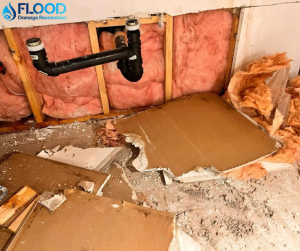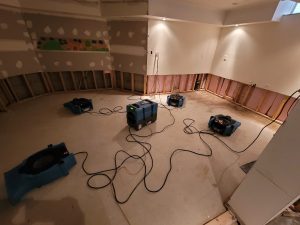Flood damage can be a devastating experience for homeowners and business owners alike. In a busy city like Toronto, the weather can be unpredictable. This means the risk of flood damage is always there. Understanding the process of flood damage restoration is essential for anyone who may find themselves in this unfortunate situation.
Understanding Flood Damage Restoration in Toronto
Flood damage is the harm caused by too much flood water. This can happen because of heavy rain, melting snow, or broken pipes. The damage can vary. It often depends on three things:
1. The amount of water.
2. The duration of the water exposure.
3. The types of materials that are affected.
Causes of Flood Damage Toronto
- Natural Disasters: Heavy rains, hurricanes, and storms can lead to significant flooding, especially in low-lying areas.
- Plumbing Failures: Burst pipes, overflowing toilets, and malfunctioning appliances can introduce large amounts of water into homes.
- Roof Leaks: Damaged roofs can allow rainwater to seep into homes, causing gradual water damage over time.
- Sewer Backups: Blocked sewer lines can cause wastewater to back up into homes, leading to serious health hazards.
Types of Toronto Flood Damage
Flood damage can be categorized into three main types:
- Category 1: Clean water from a broken pipe or appliance.
- Category 2: Grey water, which may contain contaminants but is not immediately harmful.
- Category 3: Black water, which is highly contaminated and poses serious health risks.
Understanding these categories is crucial for determining the appropriate restoration methods.
The Importance of Quick Response
When faced with flood damage, time is of the essence. The longer water remains in contact with building materials, the more extensive the damage becomes. Rapid response can significantly reduce the extent of the damage and the associated costs.
Immediate Actions to Take
- Safety First: Ensure that the area is safe. Turn off electricity and gas supplies if necessary.
- Document the Damage: Take photographs or videos of the affected areas for home insurance purposes.
- Contact Professionals: Reach out to a flood damage restoration service to initiate the cleanup process.
Benefits of Professional Help
Hiring a professional restoration service offers several advantages:
- Expertise: Trained technicians can assess the damage accurately and implement effective restoration strategies.
- Advanced Equipment: Professionals have access to industrial-grade equipment that can expedite the drying process.
- Insurance Assistance: Restoration companies often assist with insurance claims, ensuring you receive the compensation you deserve.
The Process for Flood Damage Restoration in Toronto
The restoration process involves several stages, each crucial for returning your property to its pre-damage condition.
1. Assessment and Inspection
Upon arrival, restoration professionals will conduct a thorough assessment of the damage. This includes:
- Identifying the source of the water.
- Evaluating the extent of the damage.
- Determining the type of water involved.
2. Water Extraction
Once the assessment is complete, the next step is to remove standing water. This is typically done using:
- Submersible Pumps: Ideal for removing large volumes of water quickly.
- Wet/Dry Vacuums: Useful for smaller areas and residual water.
3. Drying and Dehumidification
After water extraction, the affected areas must be thoroughly dried. This involves:
- Air Movers: High-velocity fans that circulate air to speed up evaporation.
- Dehumidifiers: Machines that remove moisture from the air, preventing mould growth.
4. Cleaning and Disinfection
Once the area is dry, thorough cleaning and disinfection are necessary to eliminate contaminants and odors. This includes:
- Disinfecting Surfaces: Using appropriate cleaning agents to kill bacteria and pathogens.
- Mold Prevention: Applying mold inhibitors to prevent future growth.
5. Restoration and Repairs
The final step involves restoring your home or property to its original state. This may include:
- Reconstruction: Repairing or replacing damaged properties, such as drywall, flooring, and insulation.
- Content Restoration: Cleaning and restoring personal belongings affected by water damage.
Preventive Measures to Minimize Flood Damage
You may not stop all basement flooding, but some steps can greatly lower the risk of flood damage.
Home Maintenance Tips
- Regular Inspections: Check your home for signs of leaks or water damage, especially in basements and attics.
- Maintain Gutters and Downspouts: Ensure that gutters are clean and that downspouts direct water away from the foundation.
- Install Sump Pumps: Consider installing a sump pump in basements to manage excess water during heavy rainfall.
- Waterproofing: Apply waterproof sealants to basement walls and floors to create a barrier against moisture.
Community Efforts
Joining community projects to improve drainage and flood management can help reduce the risk of flooding in your area.
The Role of Insurance in Flood Damage Restoration
Understanding your insurance policy is crucial when dealing with flood damage. Many homeowners’ policies do not cover flood damage, making it essential to have a separate flood insurance policy.
What to Look for in a Policy
- Coverage Limits: Ensure that the policy covers the full value of your home and belongings.
- Deductibles: Be aware of the deductible amounts and how they will affect your out-of-pocket expenses.
- Claims Process: Familiarize yourself with the claims process to expedite the recovery after a flood.
Filing a Claim
- Notify Your Insurance Company: Report the damage as soon as possible.
- Provide Documentation: Submit photographs and a detailed list of damaged items.
- Follow Up: Stay in contact with your insurance adjuster to ensure a smooth claims process.
Common Myths About Flood Damage Restoration in Toronto
Myth 1: DIY Water Damage Cleanup is Sufficient
While some minor water issues can be handled independently, significant flooding often requires professional intervention. Inadequate cleanup can lead to mold growth and structural damage.
Myth 2: All Water Damage is Covered by Insurance
Not all insurance policies cover flood damage. Reviewing your policy and considering supplemental coverage if necessary is vital.
Myth 3: Restoration is Always Expensive
The cost of restoration can vary widely based on the extent of the damage. Early intervention can prevent more extensive, costly repairs down the line.
Environmental Considerations
Waste Management
Restoration efforts can generate a significant amount of waste, including:
- Damaged materials (drywall, flooring, etc.)
- Contaminated items (furniture, appliances)
Proper disposal of these materials is essential to minimize environmental impact.
Eco-Friendly Restoration Practices
Many restoration companies are adopting eco-friendly practices, such as:
- Using biodegradable cleaning products.
- Implementing recycling programs for damaged materials.
Choosing the Right Company for Flood Damage Restoration in Toronto
Credentials and Certifications
Look for companies that have certification from well-known organizations. One example is the Institute of Inspection, Cleaning and Restoration Certification (IICRC). This ensures that the company adheres to industry standards.
Experience and Reputation
Research the company’s experience in handling flood damage restoration. Reading customer reviews and testimonials can provide insight into their reliability and quality of service.



